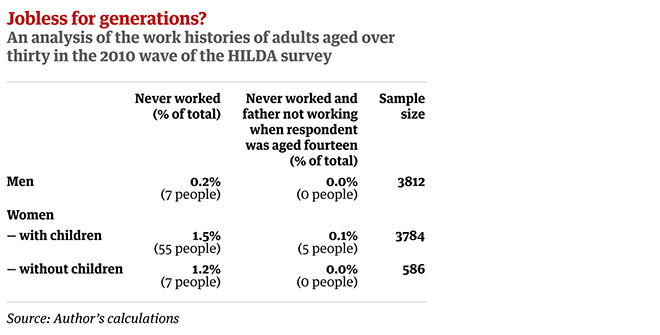At the end of the blockbuster movie Titanic, audiences weep for the drowned Leonardo DiCaprio character (travelling third class) while Kate Winslet (in first class) survives. Their fictional story matches the true facts of the 1912 Titanic disaster, which men and women travelling first class were twice as likely to have survived than those in third. Nearly all the first-class children lived; two-thirds of the third-class children perished.
In his new book, Good Times, Bad Times: The Welfare Myth of Them and Us, British social policy researcher John Hills points out that one of the starkest ways in which inequality manifests itself is through differences in mortality. One study that followed a group of mature-aged British women over a six-year period found that the poor were four times as likely to die as the rich. Similarly, economist Philip Clarke and I found that high-income Australians live, on average, six years longer than those on lower incomes. As on the Titanic, class and mortality are intertwined.
Over the past generation, both Britain and Australia have experienced a significant rise in inequality, which means that many of the findings in John Hills’s book will be familiar to Australian readers. The gap between the best-paid and worst-paid is larger now than in the 1970s, with technology, globalisation and deunionisation among the key drivers. As Hills points out, even the increase in house prices has significant implications for intergenerational mobility, with parental bequests most likely to go to those who already own property.
Volatility
A key theme of Good Times, Bad Times is the volatility of poverty. Hills describes the week-to-week income received by a high-income family as fairly dull: regular pay cheques, and occasional blips from investment income. By contrast, the same graph for a low-income family “would look more like the hospital heart monitor of someone in trouble, with big jumps and falls from week to week.” This highly erratic pattern is partly due to life events (such as losing a job or finding a partner) but also a result of means-tested government payments starting or stopping. Since there is a delay in means testing, the result can be to add to the volatility of incomes, rather than smooth it out.
Income volatility – over weeks, years or even generations – isn’t surprising when you think about it. But the puzzle is that many seem not to have thought about it. In Britain, the secretary of state for work and pensions, Iain Duncan Smith, claims that his country has council estates “where often three generations of the same family have never worked.” Yet as Hills points out, the data show that less than 1 per cent of adult men have never worked, and researchers have been unable to find even a single example of multigenerational joblessness. As one researcher puts it, verifying Duncan Smith’s claim is like “hunting the Yeti.”
What about in Australia? Here, too, a quick search turned up a number of conservative politicians making Duncan Smith’s claim. Kevin Andrews frets about “jobless households, in which many generations of Australians do not know what it is like to have a job.” Peter Dutton bemoans “households in which there is now a third generation of people who have never worked.” Ewen Jones worries about “generations of people out there who have never had a job.” The Australian editorialises about “the evidence of Australian families where three generations have never worked.”
What does the evidence say? Looking at the Household, Income and Labour Dynamics in Australia survey, I found that among men thirty or older, only one in 500 had never worked (see chart). And among this tiny sample, all the respondents reported that their father was working when they were a child. Like the British social researchers, I was unable to find a single example of a family in which both the father and son had never held down a job. The rhetoric of Andrews, Dutton and Jones seems adrift from Australian reality.

Another mistake that arises from the static view of poverty is the tendency to divide the population into “us” and “them.” In Britain, prime minister David Cameron talks about “strivers” and “skivers.” In the United States, Republican presidential candidate Mitt Romney split America into the 47 per cent “who are dependent on government” and the 53 per cent who pluckily make their own way in life. In Australia, treasurer Joe Hockey (invoking long-serving Liberal prime minister Robert Menzies) divided the nation into “leaners” and “lifters.”
The problem with this approach is that most of us move between the categories at different points in our lives. The “skivers,” the “47 per cent” and the “leaners” include retirees, students, people with disabilities, the newly jobless, and single parents whose partners have just left them. To stamp a permanent label on the forehead of any of these people makes no sense.
In Britain, Hills points out, the experience of child poverty is surprisingly widespread. Using the definition of poverty as families with less than three-fifths of the median income, he finds that only one in eight children are poor in a given year. But over the course of a decade, half of all British children will experience at least a year in poverty. Being in poverty is abnormal; being touched by poverty during childhood is not.
Taking a dynamic approach to poverty reminds us of the role the welfare state can play in managing risk. Until the late nineteenth century, individuals effectively had to self-insure against risks such as sickness, job loss, and poverty in old age. With the advent of the welfare state, the job of managing many of these risks was moved away from individuals and towards government. Taxes became like an insurance premium, to be paid out in the event of illness, unemployment or retirement.
Like Cameron, Romney and Hockey, Prussian leader Otto von Bismarck was a conservative. But Bismarck created the world’s first welfare state because he realised that we can’t split society into “us” and “them.” Speaking in the Reichstag, Bismarck argued that it is the responsibility of the state “to protect the worker from accidents and need when he is injured or becomes old.” By creating programs such as old age pensions, accident insurance, medical care and unemployment insurance, we give people greater confidence to live their lives – to have children, invest in their businesses, and try new jobs.
Complexity
Another theme that Hills explores is the impact of complexity. As he notes, many people in poverty struggle to navigate Britain’s social safety net. The system provides recipients with multiple payments, including earned income tax credits, which seek to encourage low-wage workers to increase their hours. To make matters more complicated, housing benefits are paid by local councils, and their means tests can sometimes overlap with other payments – which are mostly paid for by the national government.
To some extent, complexity is an inevitable result of a well-targeted social safety net. Indeed, this is an even bigger issue in Australia than Britain, since ours is the best-targeted social safety net in the advanced world. The average advanced country gives twice as much welfare to the bottom fifth of the population as to the top fifth; Australia gives twelve times as much to the poor as to the rich.
An inevitable result of targeting is that payments must reduce as incomes rise, and cut out entirely beyond a certain point. This helps explain why the Australian form to apply for Austudy is twenty-one pages, the form to apply for a Disability Support Pension is twenty-nine pages, and the form to apply for paid parental leave is thirty-six pages.
Ideally, governments would simplify these systems, but this isn’t as easy as it might seem. Since 2013, Britain has been attempting to combine six means-tested payments into a single universal credit. Pilot programs have been unsuccessful, problems have emerged with the software, and only a tiny fraction of British recipients are currently receiving the new payment. A system that was designed to simplify life for the poor risks making it more complicated.
Austerity
If complexity weren’t enough, low-income Britons have also found themselves grappling with a series of changes that have left them with less disposable income. These have included freezing the child benefit, raising the rate of the value-added tax (Britain’s equivalent of the GST) from 17.5 to 20 per cent, capping total household benefits, and cutting public services. Overall, the changes have been regressive, with jobless single parents losing 10 per cent of their incomes. Hills also points out that the adverse impact of the cuts has been disproportionately felt by women.
Such a story will be familiar to observers of Australian politics. The National Centre for Social and Economic Modelling’s analysis of the Abbott government’s first two budgets showed that the poorest single parents would lose 8 per cent of their disposable incomes, while affluent individuals without children would be slightly better off. Those budgets proposed reducing family payments, removing the Schoolkids Bonus, and cutting pensions.
And yet there are alternatives. One of the most fascinating charts in Good Times, Bad Times shows how various European countries chose to make budget savings during 2008–13. The sharpest contrast is between Germany, where the spending and taxation changes helped the top and hurt the bottom, and France, where the reverse was true. Spain, Italy, Ireland and Britain sit somewhere between. As Hills notes, savings measures can be progressive or regressive: “there is nothing inevitable that means that [budget changes] have to bear more heavily on those with lower… incomes.”
An anti-poverty agenda will never be sufficient to win an election. Progressive parties such as the US Democrats, British Labour and the Australian Labor Party must craft a set of “big tent” policies that will appeal to voters across the political spectrum. But part of the answer lies in making politics more inclusive. Social democrats should push back against the notion of “us” and “them” – what Barack Obama once called “slicing and dicing” the electorate. Progressives need to talk about the ways in which bad luck can strike any of us, and the fact that a good social safety net is there for all of us.
After the Titanic disaster, both Britain and America instituted inquiries. These led to the formation of an International Ice Patrol in the North Atlantic, reinforced hulls on ocean liners, and a requirement that rockets at sea be treated as distress signs by passing ships. Most importantly, the inquiries noted that the Titanic had lifeboat spaces for fewer than half its passengers. After the tragedy, all ocean liners were required to carry boats that could accommodate everyone aboard. Whether you’re travelling in first class or third class, you’re entitled to a spot in the lifeboat. •




